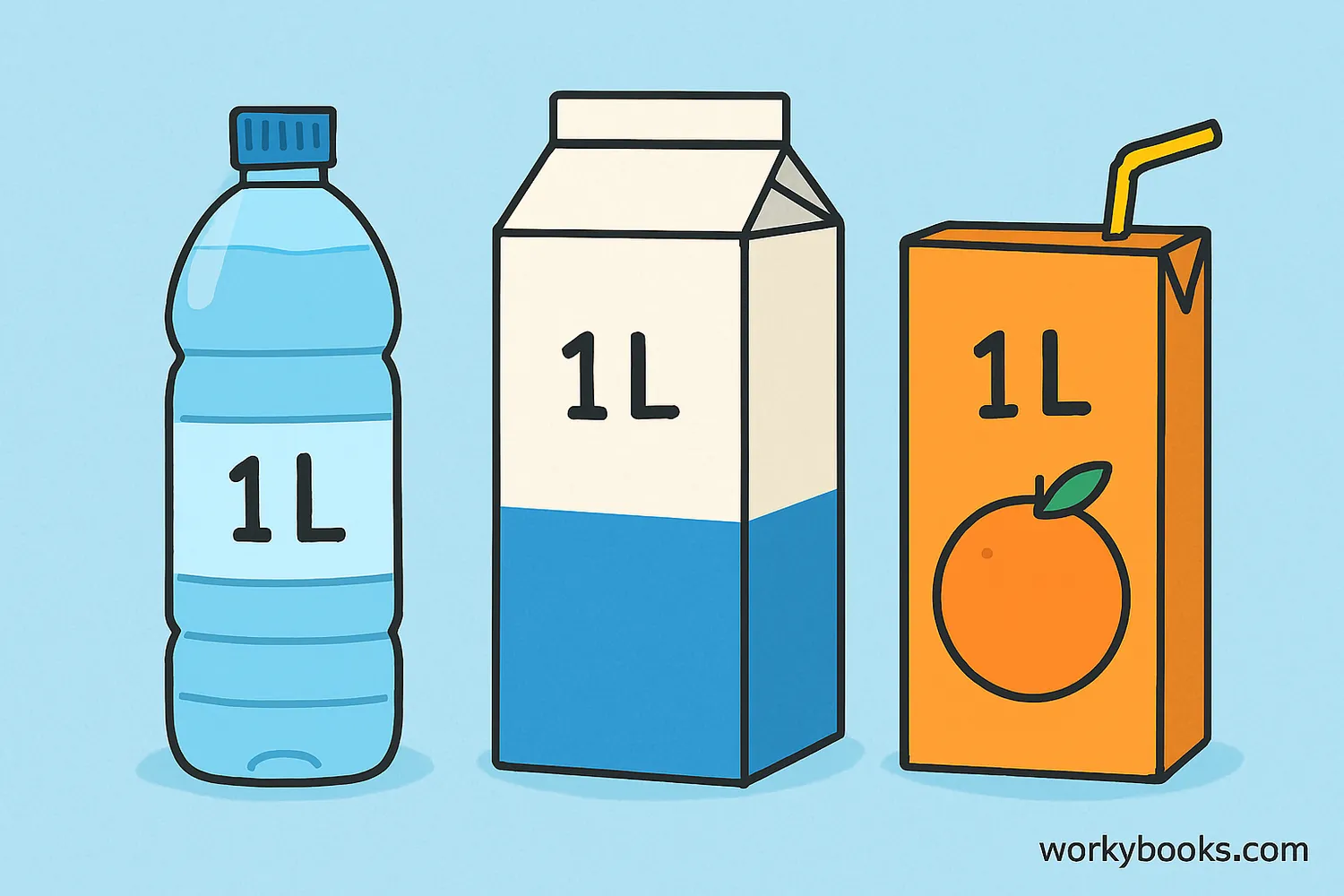Liters - Definition, Examples, Quiz, FAQ, Trivia
Learn about liters, a metric unit for measuring liquid volume, with easy explanations and practice activities
What is a Liter?

A liter is a metric unit used to measure volume, especially for liquids. The symbol for liter is L.
Liters are part of the metric system, which is used by most countries around the world. One liter is equal to 1,000 milliliters (mL). We use liters to measure amounts of liquids like water, milk, juice, and soda.
The word "liter" comes from a French word "litron" which was an old measurement unit. The modern liter was defined in 1795 as one cubic decimeter (a cube that is 10 cm on each side).
Key Concept
A liter is a metric unit for measuring volume. The symbol for liter is L, and 1 liter = 1,000 milliliters.
How Much is a Liter?
It's helpful to think about everyday objects to understand how much a liter is:
Common examples of 1 liter:
- A standard water bottle
- A small carton of milk or juice
- A large soda bottle (often 1L or 2L)
- About 4¼ cups (since 1 liter ≈ 4.22675 cups)
Liters help us understand and compare volumes. For example, if you have a 2-liter bottle of soda, you know it contains twice as much liquid as a 1-liter bottle.
Remember
Many drink containers show their volume in liters. Next time you see a water bottle or juice carton, check how many liters it contains!
Liter vs Milliliter
Milliliters (mL) and liters (L) are both metric units for measuring volume, but they measure different amounts:
Conversion Relationship
To convert between liters and milliliters, multiply or divide by 1,000.
We use milliliters to measure smaller amounts:
- Medicine doses
- Small bottles of water or juice
- Ingredients in recipes
- Bottles of soda
- Containers of milk
- Gasoline for cars
Conversion Tip
To convert liters to milliliters, multiply by 1,000. To convert milliliters to liters, divide by 1,000.
Liter vs Gallon
Liters are part of the metric system, while gallons are part of the imperial system used mainly in the United States:
Conversion Relationship
To convert between gallons and liters, multiply or divide by approximately 3.785.
Liters (Metric System):
- Used by most countries worldwide
- Based on multiples of 10 (easy to convert)
- 1 liter = 1,000 milliliters
- Used mainly in the United States
- Based on historical measurements
- 1 gallon = 4 quarts = 8 pints = 128 fluid ounces
Remember
A gallon is larger than a liter. One gallon equals approximately 3.785 liters.
Conversion Charts
Conversion charts help us quickly convert between different units of volume. Here are useful charts for converting liters:
Liters to Milliliters Conversion Chart
| Liters (L) | Milliliters (mL) |
|---|---|
| 0.1 L | 100 mL |
| 0.25 L | 250 mL |
| 0.5 L | 500 mL |
| 0.75 L | 750 mL |
| 1 L | 1,000 mL |
| 2 L | 2,000 mL |
| 5 L | 5,000 mL |
Liters to Gallons Conversion Chart
| Liters (L) | Gallons (gal) |
|---|---|
| 1 L | 0.26 gal |
| 2 L | 0.53 gal |
| 3 L | 0.79 gal |
| 4 L | 1.06 gal |
| 5 L | 1.32 gal |
| 10 L | 2.64 gal |
| 20 L | 5.28 gal |
Chart Tip
Notice the pattern: every liter contains 1,000 milliliters. This makes conversions in the metric system very easy!
Practice Quiz
Test your knowledge about liters with this 5-question quiz. Choose the correct answer for each question.
Frequently Asked Questions
Here are answers to common questions about liters:
Measurement Trivia
Discover interesting facts about measurement and liters:
Origin of the Liter
The liter was introduced in France in 1795 as part of the metric system. The original definition was the volume of 1 kilogram of water at its maximum density.
Largest Liter Container
The world's largest bottle of wine holds 490 liters—that's enough for about 650 standard bottles of wine! It stands over 4 feet tall and weighs over 1,000 pounds when full.
Water Weight
One liter of water weighs exactly one kilogram at 4°C (39°F), which is the temperature at which water is most dense. This convenient relationship makes conversions easy.
Global Usage
Only three countries in the world have not officially adopted the metric system: the United States, Liberia, and Myanmar. This means most of the world uses liters for volume measurement.


